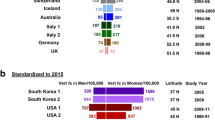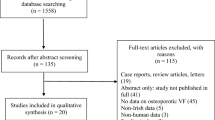Abstract
Secondary fracture prevention programs mostly identify patients with symptomatic non-vertebral fractures, whereas asymptomatic vertebral fractures are usually missed. We here describe the development and validation of a simple method to systematically identify patients with radiographic vertebral fractures using simple text-based searching of free-text radiology reports. The study consisted of two phases. In the development phase (DP), twelve search terms were used to identify vertebral fractures in all X-ray and CT reports issued over a period of 6 months. Positive reports were manually reviewed to confirm whether or not a vertebral fracture had in fact been reported. The three search terms most effective in detecting vertebral fractures during the DP were then applied during the implementation phase (IP) over several weeks to test their ability to identify patients with vertebral fractures. The search terms ‘Loss of Height’ (LoH), ‘Compression Fracture’ (CoF) and ‘Crush Fracture’ (CrF) identified the highest number of imaging reports with a confirmed vertebral fracture. These three search terms identified 581 of 689 (84%) of all true vertebral fractures with a positive predictive value of 76%. Using these three terms in the IP, 126 reports were identified of which 100 (79%) had a vertebral fracture confirmed on manual review. Amongst a sample of 587 reports in week 1 of the IP, 7 (1.2%) were false negatives. Many patients with vertebral fractures can be identified via a simple text-based search of electronic radiology reports. This method may be utilised by secondary fracture prevention programs to narrow the ‘care gap’ in osteoporosis management.

Similar content being viewed by others
References
Andrade SE, Majumdar SR, Chan AK, Buist DSM, Go AS, Goodman M, Smith DH, Platt R, Gurwitz JH (2003) Low frequency of treatment of osteoporosis among postmenopausal women following a fracture. Arch Intern Med 162:2052–2057
Elliot-Gibson V, Bogoch ER, Jamal SA, Beaton DE (2004) Practice patterns in the diagnosis and treatment of osteoporosis after a fragility fracture: a systematic review. Osteoporos Int 15(10):767–778
Giangregorio L, Papaioannou A, Cranney A, Zytaruk N, Adachi JD (2006) Fragility fractures and the osteoporosis care gap: an international phenomenon. Semin Arthritis Rheum 35(5):293–305
Leslie WD, Giangregorio LM, Yogendran M, Azimaee M, Morin S, Metge C, Caetano P, Lix LM (2012) A population-based analysis of the post-fracture care gap 1996-2008: the situation is not improving. Osteoporos Int 23(5):1623–1629
Black DM, Delmas PD, Eastell R, Reid IR, Boonen S, Cauley JA, Cosman F, Lakatos P, Leung PC, Man Z, Mautalen C, Mesenbrink P, Hu H, Caminis J, Tong K, Rosario-Jansen T, Krasnow J, Hue TF, Sellmeyer D, Eriksen EF, Cummings SR (2007) Once-yearly zoledronic acid for treatment of postmenopausal osteoporosis. N Engl J Med 356(18):1809–1822
Cranney A, Papaioannou A, Zytaruk N, Hanley D, Adachi J, Goltzman D, Murray T, Hodsman A (2006) Parathyroid hormone for the treatment of osteoporosis: a systematic review. CMAJ 175(1):52–59
Cranney A, Wells G, Willan A, Griffith L, Zytaruk N, Robinson V, Black D, Adachi J, Shea B, Tugwell P, Guyatt G (2002) Meta-analyses of therapies for postmenopausal osteoporosis. II. Meta-analysis of alendronate for the treatment of postmenopausal women. Endocr Rev 23(4):508–516
Cummings SR, San Martin J, McClung MR, Siris ES, Eastell R, Reid IR, Delmas P, Zoog HB, Austin M, Wang A, Kutilek S, Adami S, Zanchetta J, Libanati C, Siddhanti S, Christiansen C (2009) Denosumab for prevention of fractures in postmenopausal women with osteoporosis. N Engl J Med 361(8):756–765
Melton LJ 3rd, Atkinson E, Cooper C, O’Fallon W, Riggs B (1999) Vertebral fractures predict subsequent fractures. Osteoporos Int 10(3):214–221
Grundmeier R, Masino A, Casper T, Dean J, Bell J, Enriquez R, Deakyne S, Chamberlain J, Alpern E, Network PECAR (2016) Identification of long bone fractures in radiology reports using natural language processing to support healthcare quality improvement. Appl Clin Inform 7(4):1051–1068
Lacson R, Khorasani R (2011) Practical examples of natural language processing in radiology. J Am Coll Radiol 8(12):872–874
Sevenster M, Buurman J, Liu P, Peters J, Chang P (2015) Natural language processing techniques for extracting and categorizing finding measurements in narrative radiology reports. Appl Clin Inform 6(3):600–610
Do BH, Wu AS, Maley J, Biswal S (2013) Automatic retrieval of bone fracture knowledge using natural language processing. J Digit Imaging 26(4):709–713
Murff HJ, FitzHenry F, Matheny ME et al (2011) Automated identification of postoperative complications within an electronic medical record using natural language processing. JAMA 306(8):848–855
Wagholikar A, Zuccon G, Nguyen A, Chu K, Martin S, Lai K, Greenslade J (2013) Automated classification of limb fractures from free-text radiology reports using a clinician-informed gazetteer methodology. Australas Med J 6(5):301–307
Womack JA, Scotch M, Gibert C, Chapman W, Yin M, Justice AC, Brandt C (2010) A comparison of two approaches to text processing: facilitating chart reviews of radiology reports in electronic medical records. Perspect Health Inf Manag 7:1–12
Acknowledgements
This project was funded by an unrestricted research grant from the Hospital Contribution Fund (HCF) Research Foundation to JP and KG.
Author information
Authors and Affiliations
Corresponding author
Ethics declarations
Conflicts of interest
Jay Pandya, Kirtan Ganda, Lloyd Ridley and Markus J. Seibel declare that they have no conflict of interest.
Human and Animal Rights and Informed Consent
All procedures followed were in accordance with the ethical standards of the responsible committee on human experimentation (institutional and national) and with the Helsinki Declaration of 1975, as revised in 2000. The need for informed consent was waived for all patients in the study by the ethics committee.
Additional information
Publisher's Note
Springer Nature remains neutral with regard to jurisdictional claims in published maps and institutional affiliations.
Rights and permissions
About this article
Cite this article
Pandya, J., Ganda, K., Ridley, L. et al. Identification of Patients with Osteoporotic Vertebral Fractures via Simple Text Search of Routine Radiology Reports. Calcif Tissue Int 105, 156–160 (2019). https://doi.org/10.1007/s00223-019-00557-6
Received:
Accepted:
Published:
Issue Date:
DOI: https://doi.org/10.1007/s00223-019-00557-6




